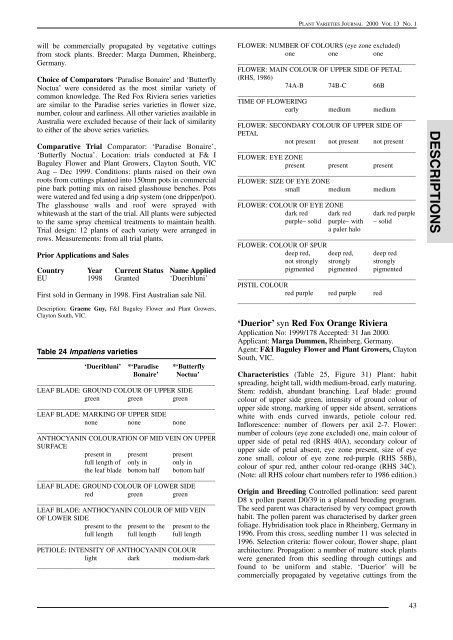53. Volume 13- Number 1 - IP Australia
53. Volume 13- Number 1 - IP Australia
53. Volume 13- Number 1 - IP Australia
Create successful ePaper yourself
Turn your PDF publications into a flip-book with our unique Google optimized e-Paper software.
DESCR<strong>IP</strong>TIONS<br />
PLANT VARIETIES JOURNAL 2000 VOL <strong>13</strong> NO. 1<br />
will be commercially propagated by vegetative cuttings<br />
from stock plants. Breeder: Marga Dummen, Rheinberg,<br />
Germany.<br />
Choice of Comparators ‘Paradise Bonaire’ and ‘Butterfly<br />
Noctua’ were considered as the most similar variety of<br />
common knowledge. The Red Fox Riviera series varieties<br />
are similar to the Paradise series varieties in flower size,<br />
number, colour and earliness. All other varieties available in<br />
<strong>Australia</strong> were excluded because of their lack of similarity<br />
to either of the above series varieties.<br />
Comparative Trial Comparator: ‘Paradise Bonaire’,<br />
‘Butterfly Noctua’. Location: trials conducted at F& I<br />
Baguley Flower and Plant Growers, Clayton South, VIC<br />
Aug – Dec 1999. Conditions: plants raised on their own<br />
roots from cuttings planted into 150mm pots in commercial<br />
pine bark potting mix on raised glasshouse benches. Pots<br />
were watered and fed using a drip system (one dripper/pot).<br />
The glasshouse walls and roof were sprayed with<br />
whitewash at the start of the trial. All plants were subjected<br />
to the same spray chemical treatments to maintain health.<br />
Trial design: 12 plants of each variety were arranged in<br />
rows. Measurements: from all trial plants.<br />
Prior Applications and Sales<br />
Country Year Current Status Name Applied<br />
EU 1998 Granted ‘Dueribluni’<br />
First sold in Germany in 1998. First <strong>Australia</strong>n sale Nil.<br />
Description: Graeme Guy, F&I Baguley Flower and Plant Growers,<br />
Clayton South, VIC.<br />
Table 24 Impatiens varieties<br />
‘Dueribluni’ *‘Paradise *‘Butterfly<br />
Bonaire’ Noctua’<br />
____________________________________________________<br />
LEAF BLADE: GROUND COLOUR OF UPPER SIDE<br />
green green green<br />
____________________________________________________<br />
LEAF BLADE: MARKING OF UPPER SIDE<br />
none none none<br />
____________________________________________________<br />
ANTHOCYANIN COLOURATION OF MID VEIN ON UPPER<br />
SURFACE<br />
present in present present<br />
full length of only in only in<br />
the leaf blade bottom half bottom half<br />
____________________________________________________<br />
LEAF BLADE: GROUND COLOUR OF LOWER SIDE<br />
red green green<br />
____________________________________________________<br />
LEAF BLADE: ANTHOCYANIN COLOUR OF MID VEIN<br />
OF LOWER SIDE<br />
present to the present to the present to the<br />
full length full length full length<br />
____________________________________________________<br />
PETIOLE: INTENSITY OF ANTHOCYANIN COLOUR<br />
light dark medium-dark<br />
____________________________________________________<br />
FLOWER: NUMBER OF COLOURS (eye zone excluded)<br />
one one one<br />
____________________________________________________<br />
FLOWER: MAIN COLOUR OF UPPER SIDE OF PETAL<br />
(RHS, 1986)<br />
74A-B 74B-C 66B<br />
____________________________________________________<br />
TIME OF FLOWERING<br />
early medium medium<br />
____________________________________________________<br />
FLOWER: SECONDARY COLOUR OF UPPER SIDE OF<br />
PETAL<br />
not present not present not present<br />
____________________________________________________<br />
FLOWER: EYE ZONE<br />
present present present<br />
____________________________________________________<br />
FLOWER: SIZE OF EYE ZONE<br />
small medium medium<br />
____________________________________________________<br />
FLOWER: COLOUR OF EYE ZONE<br />
dark red dark red dark red purple<br />
purple– solid purple– with – solid<br />
a paler halo<br />
____________________________________________________<br />
FLOWER: COLOUR OF SPUR<br />
deep red, deep red, deep red<br />
not strongly strongly strongly<br />
pigmented pigmented pigmented<br />
____________________________________________________<br />
PISTIL COLOUR<br />
red purple red purple red<br />
____________________________________________________<br />
‘Duerior’ syn Red Fox Orange Riviera<br />
Application No: 1999/178 Accepted: 31 Jan 2000.<br />
Applicant: Marga Dummen, Rheinberg, Germany.<br />
Agent: F&I Baguley Flower and Plant Growers, Clayton<br />
South, VIC.<br />
Characteristics (Table 25, Figure 31) Plant: habit<br />
spreading, height tall, width medium-broad, early maturing.<br />
Stem: reddish, abundant branching. Leaf blade: ground<br />
colour of upper side green, intensity of ground colour of<br />
upper side strong, marking of upper side absent, serrations<br />
white with ends curved inwards, petiole colour red.<br />
Inflorescence: number of flowers per axil 2-7. Flower:<br />
number of colours (eye zone excluded) one, main colour of<br />
upper side of petal red (RHS 40A), secondary colour of<br />
upper side of petal absent, eye zone present, size of eye<br />
zone small, colour of eye zone red-purple (RHS 58B),<br />
colour of spur red, anther colour red-orange (RHS 34C).<br />
(Note: all RHS colour chart numbers refer to 1986 edition.)<br />
Origin and Breeding Controlled pollination: seed parent<br />
D8 x pollen parent D0/39 in a planned breeding program.<br />
The seed parent was characterised by very compact growth<br />
habit. The pollen parent was characterised by darker green<br />
foliage. Hybridisation took place in Rheinberg, Germany in<br />
1996. From this cross, seedling number 11 was selected in<br />
1996. Selection criteria: flower colour, flower shape, plant<br />
architecture. Propagation: a number of mature stock plants<br />
were generated from this seedling through cuttings and<br />
found to be uniform and stable. ‘Duerior’ will be<br />
commercially propagated by vegetative cuttings from the<br />
43

















